A one-hour drive from downtown Sukhothai to Si Satchanalai district, the Suntree Thai Weaving Center is a place where a group of local skilful weavers gather to work on old wood looms that are all set up in the middle of the green courtyard.

Wat Chang Lom at Si Satchanalai Historical Park houses Buddha relics. (Photo: Pattarawadee Saengmanee)


They have managed to keep their traditional weaving techniques alive and to create elaborate phasin — a long fabric which is often wrapped around the waist like a skirt –in nine classic patterns, which highlight the unique lifestyle and customs of the Thai-Puan people.
Back in 1994, Suntree Wichitnak formed a textile weaving group to increase income during the off-season before converting her home into a learning centre. As a result, the Support Arts and Crafts International Centre of Thailand named her a master artisan to honour her services in the conservation of the exquisite legacy of the Thai-Puan ethnic people.
Raweewan Khanadnid, her daughter, follows in her footsteps by developing creative workshops for visitors to learn how to hand-spin cotton, weave teen jok fabric, or create keychains out of various materials like beads, textile scraps, pom-poms, and fabric buttons. The rates per person range between 200 and 600 baht.
“In the past, learning how to weave textiles used to be a requirement for all Thai-Puan women; otherwise, we couldn’t marry. Hedgehog hair has been used extensively in the weaving process to make beds, blankets, and fabrics for use in our homes. We dyed our cloth in three major colours: red from lac resin, yellow from jackfruit heartwood, and green from jackfruit heartwood with kram (indigo),” Raweewan said.
“We continue to maintain nine traditional patterns, all of which are inspired by our surroundings and nature such as nam ang (a pair of birds), pad kho (eight hooks) and krue (flower). A weaver typically takes around a few months to finish a teen jok and the skirt body. Cotton phasin can cost up to 15,000 baht, while silk phasin with golden thread can go for 150,000 baht a piece.”
Their original wood house has now become a living museum showcasing Thai-Puan architecture and culture. A kitchen still has a wide range of vintage pottery and tableware, whereas a living area is versatile for everyday activities and for other family members to set up a mat as an open-air sleeping space overnight. Without windows, a bedroom is just for daughters, and a little hole in the floor serves as a communication link with their lovers outside.
Located 13km from the weaving centre, Si Satchanalai Historical Park has become a significant mythical portal that allows visitors to travel back in time to the 13th-14th centuries when the town of Chaliang was founded and served as the crown prince’s residence before being relocated and given its current name. This helps us to better comprehend our ancestry.
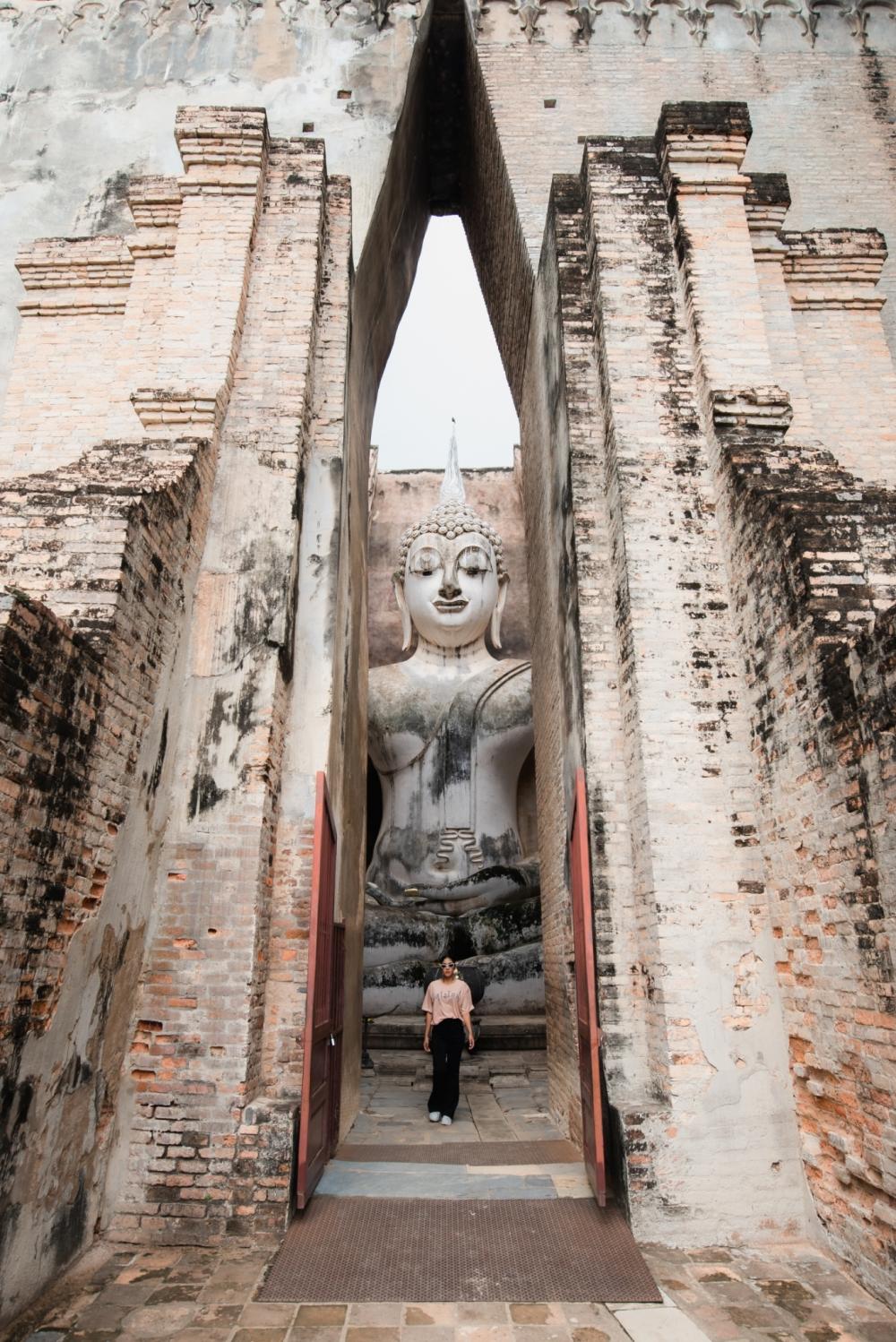
Sukhothai Historical Park’s Wat Si Chum houses a colossal statue of Phra Vajana. (Photo: KTC PR)
It stretches across a 28,000 rai (44.8km²) parcel of land on the banks of the Yom River and is home to more than 20 ruins of ancient temples and historical monuments, where tourists can hire a bike or take a tram for a sightseeing tour. This complex combines the architectural styles of Sukhothai, Lanka, Bayon, and Ayutthaya, as Hinduism and Buddhism stretched their borders throughout Southeast Asia.
The laterite rampart surrounds the inner city, and our first visit is Wat Chang Lom. This temple is believed to have been built to house the Lord Buddha’s relics in the mid 19th and early 20th centuries BE, when Lanka art was spreading its influence to the Sukhothai kingdom. It is enclosed by a modest wall, which represents the border between the human world and the heaven of the Buddhist universe.
A large open-air wihan (hall for Buddha shrines) was constructed of laterite and cement, while 39 sculptures of elephants from the Himmaphan forest act as guardians at the base of a towering Sukhothai-style stupa depicting Mount Meru. On the upper level, it is embellished with Bagan-style architectural elements and 20 Buddha-like stuccos in the posture of subduing Mara, with the pole of a royal umbrella decorated with a Lanka-style sculpture of a walking Buddha.
“This temple is famous for an assortment of architectural arts. There is a bell-shaped stupa inspired by a Lanka-style design, a Bagan-style pillar and a Sukhothai-style Buddha statue with a flame-like halo on its head, long ears, and smiling face showing a South Indian influence,” said the archaeology guide Weerapong Kamduang.
Back on the ground, visitors can stroll a short distance to Wat Chedi Ched Taew, where 33 ruined stupas of various patterns have been erected to depict the Buddhist cosmos. It was hypothesised that this hoary temple functioned as the royal cemetery of the Sukhothai dynasty since all of the stupas contained unidentified ashes and had terracotta ornaments.

Far right The 84-year-old Sawankhalok Police Station won the Architecture Conservation Award from the Association of Siamese Architects. (Photo: KTC PR)
“The pagodas in this temple were shaped differently to highlight the distinctive Sukhothai, Lanna, and Khmer styles. This might be a result of artisans travelling and acquiring expertise from many civilisations. Laterite was mostly utilised to construct the monuments in this town since it was traditionally a laterite source in the lower north,” Weerapong explained.
After exploring the historic town, we continued to study the origins of the Sukhothai-style talismans at Baan Phra Phim Laksamonsilp. Situated in the Muang district, it was the idea of Narongchai Torin to transform his house into a gallery and offer innovative workshops in order to conserve the legacy of producing votive tablets for future generations.
“There are 1,200 distinctive designs of Sukhothai-era votive tablets and I spent 20 years researching them. Votive tablets have been developed to foster Buddhism, and they serve as a gateway to Buddhist doctrines,” he said.
Those seeking one-of-a-kind keepsakes may learn how to press soft clay into small moulds to create votive tablets in various designs such as Phra Nang Phraya Saneh Chan for charm and power, Phra Luang Prathan Phon for prosperity, and Phra Khun Phaen for good fortune and love.
We woke up early the next morning and went to a fresh market to buy food, fruits, and sweets to give to the monks as alms. After breakfast, we headed to the Sukhothai Historical Park, which spans 70km and boasts more than 20 ruins of archaic monuments and archaic kilns that show links to various civilisations, resulting in the development of Thai architecture.
Set against the backdrop of Khao Pratak Mountain, this historic town boasts three layers of city walls and moats erected during the Sukhothai and Ayutthaya eras. The Fine Arts Department has enhanced the scenery with coconut, jackfruit, and tamarind to mimic the original scenes from 800 years ago.
A sightseeing tour might begin at Wat Si Chum to worship an enormous statue of Phra Vajana, which is mentioned in the first and second stone inscriptions. Built in the 14th century, a brick roof has fallen, but a staircase still takes visitors to the top of the mondop (a square-based religious structure topped with a spire), whose ceiling once housed carved slate slabs depicting scenes from the Jataka stories in Lankan-style art.
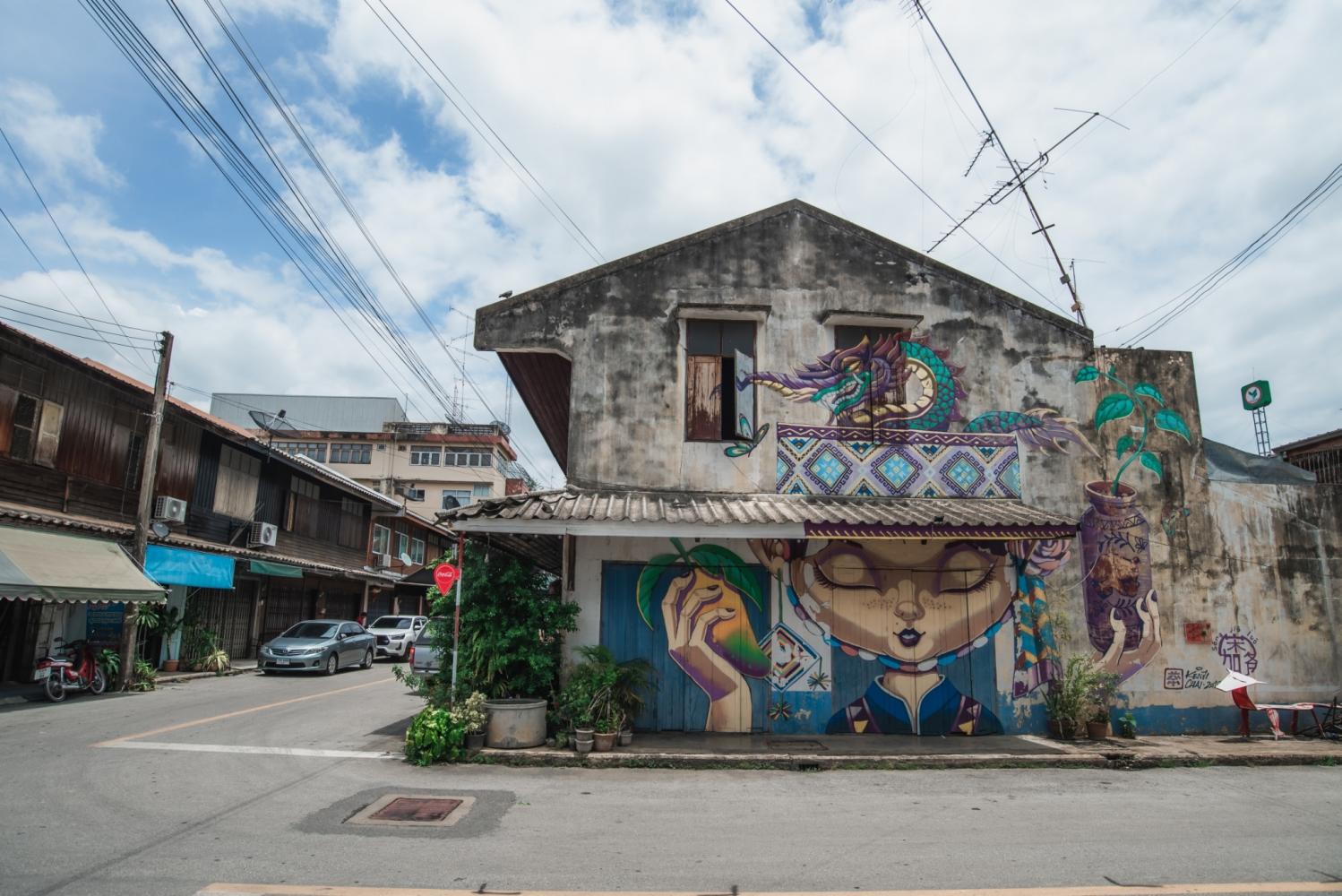
Colourful street art enlivens Sawankhalok’s historic business district. (Photo: KTC PR)
According to legend, during the Siamese-Burmese war, King Naresuan established a camp here and ascended a mondop’s stairs to make a speech to motivate his troops, leading many to believe that this tall Buddha could talk.
Among the attractions is Wat Si Sawai, which has three Lopburi-style stupas. Influenced by Bayon-style architecture, this compound was originally a Hindu sanctuary to house a Shiva lingam statue until Buddhism spread to the Sukhothai kingdom and an assembly hall was constructed.
“Normally, Buddhist temples face east to absorb the energy of the Sun, but this temple’s wihan faces south, towards the Lopburi kingdom or the Angkor Thom. It was renovated during the Ayutthaya period, and its chedi is adorned with Khmer-style stuccos of deities and a garuda catching a naga as guardians. There are also Chinese-style floral and plant patterns from the early Ayutthaya period on display,” Weerapong explained.
Just a stone’s throw away, Wat Mahathat is home to the royal graveyard with 200 stupas containing ashes. This temple symbolises the core of the Buddhist universe, which is surrounded by an ocean. The main stupa was erected in Sukhothai style and adorned with Lanka-style stuccos depicting the Buddha’s birth and nirvana as well as his disciples walking clockwise.
On the last day, we travelled to the old town of Sawankhalok and saw its historic commercial centre, which is located on the east bank of the Yom River. The 600m walking tour starts with the half-timbered, Panya-style railway station, built in 1909.

The Suntree Thai Weaving Center promotes itself as a living museum for young generations to learn about Thai-Puan culture. (Photo: Pattarawadee Saengmanee)



This simple-looking combination of traditional craftsmanship and Western architecture carried its influence from Europe to Siam between the reigns of King Rama V and Rama VII. This station was briefly closed after the Covid-19 outbreak and was recently reopened to provide a direct link between Sawankhalok and Uttaradit’s Sila-at station.
Just a few metres from a train station, the old business district is bordered by classic shophouses, with striking street art illustrating the way of local life on the walls. During the reigns of King Rama V to King Rama VIII, the town of Sawankhalok functioned as a significant trading port, where Chinese merchants from Bangkok and Ayutthaya assembled and traded cotton, tobacco, rice and timber.
At the end of the trail is the 84-year-old Sawankhalok Police Station, which has received the Architecture Conservation Award from the Association of Siamese Architects. Constructed using teak and tabaek wood in a Panya-style architecture, it is currently converted into a neighbourhood museum complete with two jail cells, a conference room and a showcase of vintage office supplies and police uniforms.
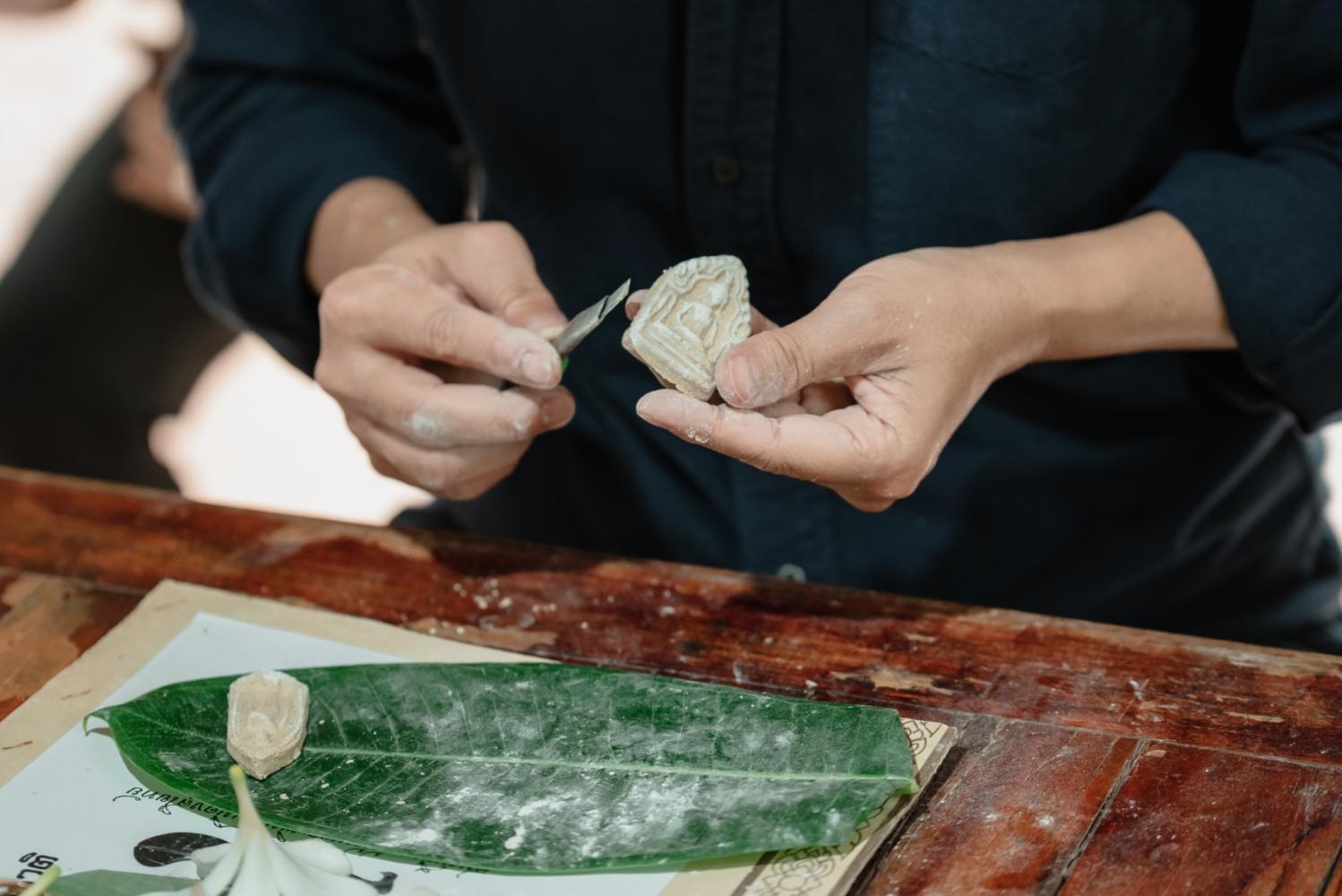
Baan Phra Phim Laksamonsilp provides interesting workshops on making Sukhothai-style votive tablets. (Photo: KTC PR)

Travel info
Suntree Thai Weaving Center is at 329, Si Satchanalai District, Sukhothai. It’s open daily from 8am to 5pm. Call 089-858-8576 or visit suntreestyle.com.
Baan Phra Phim Laksamonsilp is in Muang district, Sukhothai. Call 081-197-0535 or visit facebook.com/banpraphimon.
Sukhothai Historical Park is in Muang district, Sukhothai. It’s open 6.30am to 7.30pm from Monday to Friday and Sunday, and from 6.30am to 9pm on Saturday. The entrance fees are 20 baht for Thais and 100 baht for foreigners. Call 055-697-527 or visit finearts.go.th/sukhothaihistoricalpark.
Si Satchanalai Historical Park is in Si Satchanalai District, Sukhothai. It’s open daily from 8am to 5pm. Admission is 10 baht for Thais and 30 baht for foreigners. Call 055-679-211 or visit finearts.go.th/sisatchanalaihistoricalpark.
Travellers with a KTC-Bangkok Airways credit card may redeem 55 points for a 550 baht discount when
booking a domestic or international flight at bangkokair.com until Dec 31.
KTC World provides a three-day Fly to Sukhothai Low Carbon package that includes a round-trip ticket from Bangkok to Sukhothai, a two-night stay at Lagendha Sukhothai Resort, a bicycle tour of Sukhothai Historical Park, and workshops. Prices start at 6,550 baht per person, and KTC-Bangkok Airways cardholders will receive a 500-baht per person discount when reserving and flying through Dec 25.

Wat Si Sawai at Sukhothai Historical Park is home to three Lopburi-style stupas. (Photo: KTC PR)
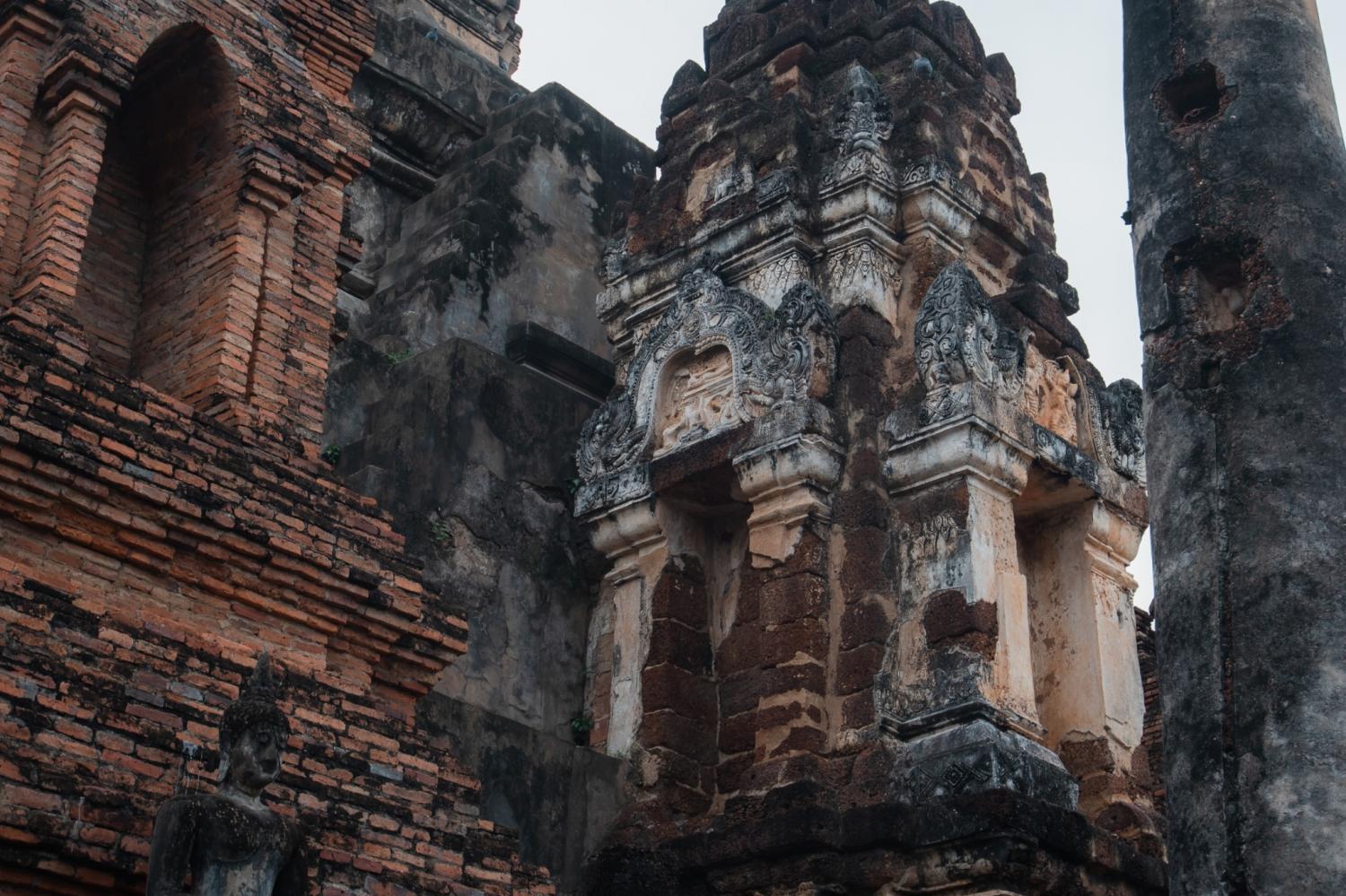
Wat Mahathat in Sukhothai Historical Park serves as a royal cemetery with 200 stupas containing ashes. (Photo: KTC PR)
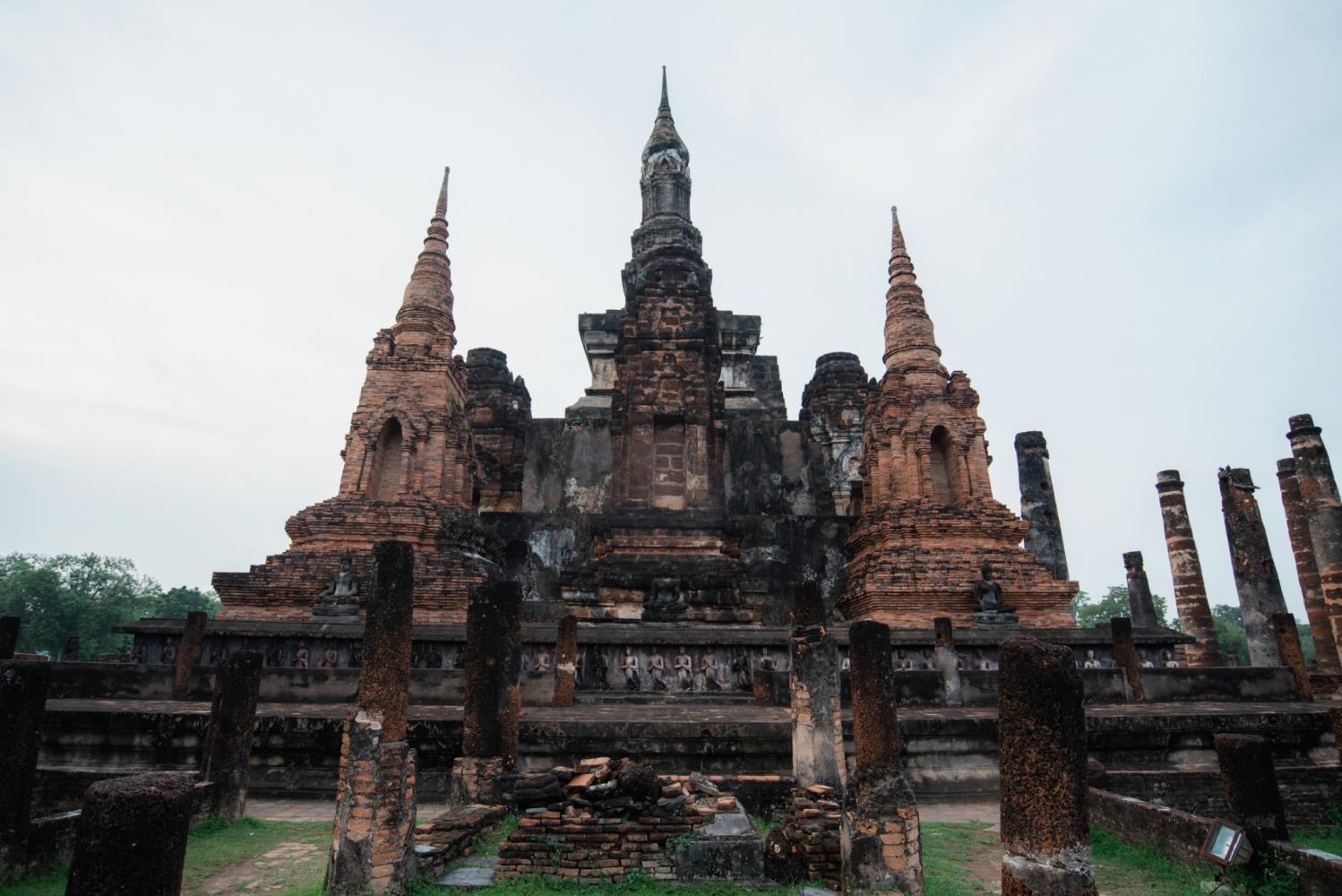

The Panya-style Sawankhalok railway station was constructed in 1909. (Photo: KTC PR)



